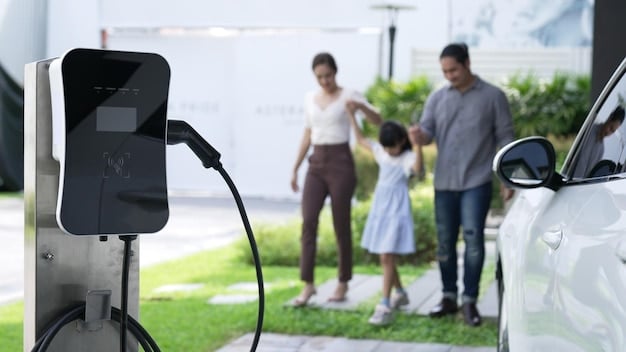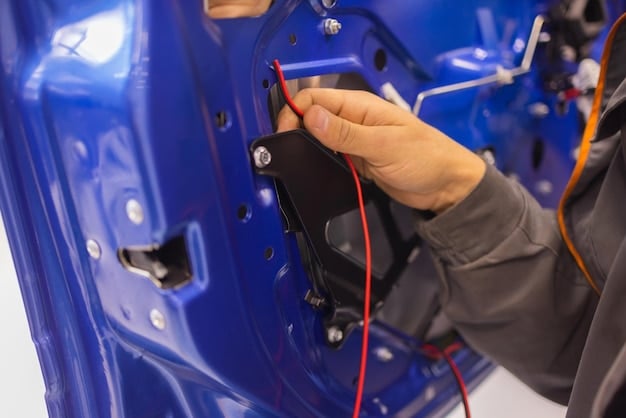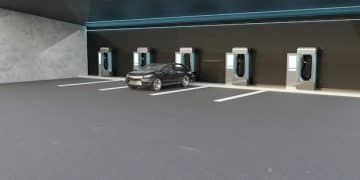Electric Vehicle Policy Update: EVs Mandated by 2035 – What You Need to Know

A new federal regulation mandates all new vehicles sold in the US to be electric by 2035, marking a significant shift in the automotive industry and requiring consumers to understand the implications for vehicle availability, charging infrastructure, and long-term costs.
The automotive landscape in the United States is poised for a dramatic transformation. A new Electric Vehicle Policy Update: New Federal Regulations Mandate All New Vehicles Be Electric by 2035 – What You Need to Know. This landmark decision will reshape vehicle manufacturing, consumer choices, and the nation’s infrastructure. What does this mean for you, the driver? Let’s dive into the specifics of this game-changing policy and its potential effects.
Understanding the 2035 Electric Vehicle Mandate
The headline is clear: by 2035, all new cars and trucks sold in the United States must be electric vehicles (EVs). But what’s driving this change, and what are the key elements of the new policy? This section explores the motivations behind the mandate and its anticipated rollout.
The Rationale Behind the EV Mandate
The push for electric vehicles is rooted in several critical factors, primarily environmental concerns and energy independence. Here’s a closer look:
- Reducing Greenhouse Gas Emissions: Transportation is a major contributor to greenhouse gas emissions. Electric vehicles produce zero tailpipe emissions, significantly reducing the carbon footprint of the transportation sector.
- Improving Air Quality: Gasoline-powered vehicles release pollutants that contribute to smog and respiratory problems. EVs offer cleaner air, especially in densely populated urban areas.
- Promoting Energy Independence: Shifting to electric vehicles reduces reliance on foreign oil and promotes the use of domestically generated electricity, including renewable sources like solar and wind.
Key Components of the New Regulations
The 2035 mandate isn’t just a simple switchover date; it involves a phased approach with specific requirements and incentives. Some key components include:
- Gradual Implementation: The regulations will likely phase in over time, with increasing percentages of EV sales required each year leading up to 2035.
- Incentives and Rebates: To encourage adoption, the policy will likely include incentives for consumers to purchase EVs, such as tax credits and rebates.
- Infrastructure Development: A critical aspect of the mandate is the expansion of charging infrastructure to support the growing number of EVs on the road. This includes public charging stations, home charging options, and grid upgrades.
The 2035 electric vehicle mandate represents a bold step towards a sustainable transportation future. By understanding the rationale behind this policy and its key components, we can better anticipate the changes and prepare for the shift to electric mobility.
Impact on Consumers: What to Expect
The 2035 mandate will undoubtedly impact consumers in various ways, from vehicle choices and costs to infrastructure accessibility. This section helps you understand how this transition will affect you as a driver.

Vehicle Availability and Choices
The shift to EVs means a gradual reduction in the availability of new gasoline-powered vehicles. Consumers can expect:
- Expanding EV Options: Automakers will focus on developing and offering a wider range of electric models across different vehicle segments, from sedans and SUVs to trucks and vans.
- Phase-Out of Gasoline Vehicles: As the mandate approaches, the selection of new gasoline-powered vehicles will decrease, eventually leading to their discontinuation by 2035.
- Used Car Market Considerations: The used car market will still offer gasoline-powered vehicles, but their value and availability may be affected by the increasing popularity of EVs.
Cost Considerations: Purchase Price and Running Costs
The cost of owning and operating a vehicle is a significant concern for most consumers. Here’s how the mandate might affect your wallet:
Electric vehicles typically have a higher upfront purchase price compared to gasoline-powered cars. However, government incentives and tax credits can help offset this difference. Furthermore, EVs have lower running costs due to cheaper electricity compared to gasoline and reduced maintenance requirements.
The 2035 mandate will bring about significant changes for consumers, reshaping vehicle choices, costs, and infrastructure. Understanding these impacts is crucial for making informed decisions in the evolving automotive market.
Charging Infrastructure: Readiness and Expansion
A robust and accessible charging infrastructure is essential for the successful adoption of electric vehicles. This section assesses the current state of charging infrastructure in the US and the plans for expansion to meet the growing demand.
Current State of Charging Infrastructure
The existing charging infrastructure in the United States is still developing, with uneven distribution and varying levels of availability.
- Public Charging Stations: The number of public charging stations is growing, but it remains insufficient to support widespread EV adoption.
- Home Charging: Many EV owners rely on home charging, which requires installation of a Level 2 charger for faster charging speeds.
- Charging Speeds: Charging speeds vary depending on the charger type, with Level 3 fast chargers offering the quickest charging times.
Expansion Plans and Investments
Recognizing the importance of charging infrastructure, significant investments are being made to expand the network.
The federal government and private companies are investing heavily in building new charging stations across the country. These investments aim to increase the number of charging locations, improve charging speeds, and ensure reliable service. Strategic placement of charging stations along major highways and in urban areas is crucial to address range anxiety and support long-distance travel.
The expansion of charging infrastructure is a critical factor in the success of the 2035 electric vehicle mandate. By investing in a robust and accessible charging network, the US can support the growing number of EVs on the road and ensure a smooth transition to electric mobility.
Challenges and Opportunities in the Transition
The transition to an all-electric vehicle fleet presents both challenges and opportunities for various stakeholders, including automakers, consumers, and the government.
Challenges Facing Automakers
Automakers face significant challenges in adapting to the 2035 mandate. Some of these challenges include:
Automakers must invest heavily in research and development to design and manufacture a wide range of electric vehicles that meet consumer needs and preferences. This requires significant capital investment and technological innovation. Additionally, automakers need to secure reliable supplies of critical materials for batteries, such as lithium and cobalt. Supply chain disruptions and price volatility can impact production costs and timelines.
Retraining the workforce to manufacture and service electric vehicles is another significant challenge. Automakers need to provide training programs to equip employees with the skills necessary to work with EV technology.
Opportunities for Innovation and Growth
The transition to EVs also presents numerous opportunities for innovation and growth.
The shift to electric vehicles creates opportunities for developing new battery technologies that offer improved energy density, faster charging times, and longer lifespans. Innovations in battery technology can enhance the performance and affordability of EVs. Moreover, the deployment of charging infrastructure opens up opportunities for new businesses and services, such as charging station operators, energy management providers, and software developers.

The transition to an all-electric vehicle fleet presents both challenges and opportunities for the automotive industry. By addressing the challenges and embracing the opportunities, the US can lead the way in electric vehicle innovation and manufacturing.
The Role of Government and Policy
Government policies and regulations play a crucial role in driving the adoption of electric vehicles and supporting the 2035 mandate. This section examines the key policies and incentives that are shaping the EV market.
Federal and State Incentives
Government incentives are designed to encourage consumers to purchase EVs and accelerate the transition to electric mobility.
- Tax Credits: The federal government offers tax credits for the purchase of new electric vehicles. These credits can significantly reduce the upfront cost of an EV, making it more affordable for consumers.
- Rebates: Some states offer rebates for EV purchases, often in addition to the federal tax credit. Rebates provide a direct discount on the purchase price of an EV.
- Other Incentives: Other incentives may include exemptions from vehicle registration fees, access to HOV lanes, and preferential parking for EVs.
Regulatory Framework and Standards
Government regulations and standards are essential for ensuring the safety and performance of electric vehicles.
Government agencies set standards for battery safety, charging infrastructure, and vehicle emissions. These standards help ensure that EVs are safe to operate and meet environmental requirements. Regulations also promote interoperability and compatibility between different charging systems, making it easier for EV owners to charge their vehicles at various locations.
Government policies and regulations are key drivers of EV adoption. By providing incentives and establishing clear standards, the government can create a supportive environment for the growth of the electric vehicle market.
Future Outlook: Beyond 2035
The 2035 electric vehicle mandate is just the beginning of a long-term transformation in the transportation sector. This section looks ahead to the future and explores potential developments beyond 2035.
Long-Term Impact on the Automotive Industry
The transition to an all-electric vehicle fleet will have a profound impact on the automotive industry.
Automakers will need to continue investing in electric vehicle technology and expanding their EV product lines. The industry will likely see further consolidation and partnerships as companies collaborate to develop new technologies and share resources. The shift to EVs will also create new opportunities for suppliers of battery components, charging infrastructure, and other EV-related products and services.
Potential Advancements in EV Technology
Future advancements in EV technology will further enhance the performance, affordability, and convenience of electric vehicles.
Researchers are working on developing next-generation battery technologies that offer higher energy density, faster charging times, and longer lifespans. Innovations in battery management systems and thermal management can improve battery performance and safety. Wireless charging technology, autonomous driving features, and vehicle-to-grid (V2G) technology have the potential to transform the way we use and interact with electric vehicles.
| Key Point | Brief Description |
|---|---|
| 🚗 2035 Mandate | All new vehicles sold must be electric. |
| ⚡ Infrastructure | Charging stations will significantly expand. |
| 💰 Incentives | Tax credits and rebates will aid EV adoption. |
| 🌱 Environment | Aims to reduce emissions and improve air quality. |
Frequently Asked Questions
▼
After 2035, you won’t be able to buy new gasoline-powered cars, but you can still purchase used ones. The existing gasoline cars can be driven, repaired, and resold. The mandate applies only to new vehicle sales.
▼
Electric cars typically have a higher upfront cost but lower running costs. Government incentives can help offset the initial expense. Over time, EVs may become more affordable due to advancements in battery technology.
▼
Charging times vary depending on the charger type and battery capacity. Level 2 chargers (240V) can fully charge an EV overnight, while DC fast chargers can provide a significant charge in about 30 minutes.
▼
You can charge your EV at home using a Level 2 charger, at public charging stations, and at some workplaces. The charging infrastructure is expanding to accommodate the growing number of electric vehicles on the road.
▼
Yes, electric cars produce zero tailpipe emissions, reducing air pollution. When powered by renewable energy, EVs have a significantly lower carbon footprint than gasoline-powered vehicles. They contribute to cleaner air and a more sustainable environment.
Conclusion
The 2035 electric vehicle mandate marks a significant turning point in the automotive industry, paving the way for a cleaner and more sustainable transportation future. As the transition unfolds, understanding the implications, challenges, and opportunities will be crucial for consumers, automakers, and policymakers alike.





